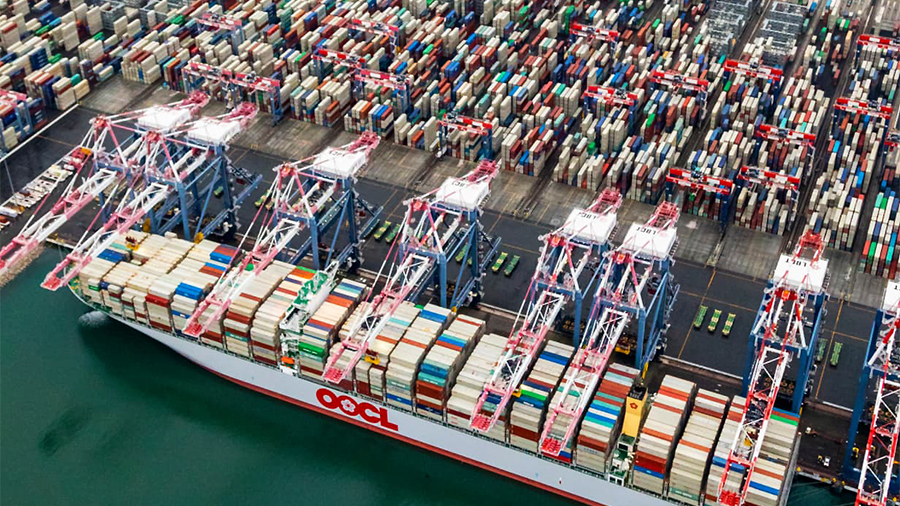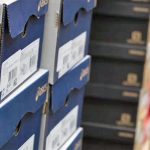Most retailers in the active lifestyle space again broadly delivered third-quarter results that topped Wall Street’s targets and lifted their 2021 guidance as sales momentum remained resilient. However, supply chain concerns, marked by port congestion and factory shutdowns in Vietnam, were widely discussed on recent quarterly calls. Insights from Dick’s Sporting Goods, Hibbett, Academy Sports + Outdoors, Big 5, Kohl’s, Foot Locker, Lululemon, and others follow.
» Dick’s Sporting GoodsBoosts Pre-Orders To Support Oversized Growth
At Dick’s inventory levels at the close of the third quarter increased 7.3 percent compared to the end of Q3 last year. Consolidated same-store sales for the third quarter ended October 30 increased 12.2 percent on top of a 23.2 percent increase in the third quarter of 2020 and a 6.0 percent increase in the third quarter of 2019.
Dick’s raised its full-year guidance and now expects same-store sales in the range of 24.0 percent to 25.0 percent, up from 18.0 percent to 20.0 percent previously.
DKS said its buying team continues to aggressively chase product to meet demand, and inventory availability overall is being prioritized over cost.
“Amidst a very dynamic environment, our team has done an excellent job working with our vendor partners and with our vertical brand manufacturers to ensure a robust flow product to meet strong demand,” said Lauren Hobart, president and CEO, on its November 23 analyst call. “We ordered aggressively to get ahead of this disruption, and our quarter-ending inventory levels increased 7.3 percent compared to the end of the same period last year. While there will continue to be inventory challenges across the marketplace, our fourth quarter is off to a strong start, and we feel that we are well-positioned within our industry this holiday season.”
Gross margins in the third quarter improved 334 basis points as higher supply chain and input costs were offset by higher merchandise margins due to fewer promotions.
Navdeep Gupta, CFO, said on the call, “Looking ahead, we continue to aggressively chase product to meet demand and prioritize inventory availability over costs. As part of this, we expect elevated freight expenses to continue at least in the fourth quarter and have included this impact within our outlook. To reiterate Lauren’s comment, while there will continue to be supply chain challenges across the marketplace, we feel that we are very well positioned within our industry this holiday season.”
»Academy Reaches Strongest Inventory Position In Two Years
Academy Sports + Outdoors started the quarter with inventory up 24 percent versus last year and ended the quarter with inventory up 22 percent. The increase came despite the net revenue in the third quarter ended October 30, increasing 18.1 percent year-over-year and 39.1 percent.
Steve Lawrence, EVP and chief merchandising officer, said “probably the greatest enabler” of Academy’s strong growth is its ability to get back in stock on product. Added Lawrence, “More importantly, the content and overall quality of this inventory is much more balanced versus last year heading into our peak weeks. We’re back in stock in most categories, and we believe that we’re well-positioned to take advantage of the fourth quarter holiday traffic.”
Michael Mullican, EVP and CFO, said Academy achieved its strongest inventory position in two years despite the ongoing challenging environment. He said, “The supply chain is benefiting from Academy’s status as a preferred vendor partner, our extensive interface and broad and diverse product assortment, our improved planning capabilities, our valuable partnerships with ports of Houston and Savannah, and a strong financial position and flexibility.”
» Hibbett’s Inventories Climb 23 Percent Year-Over-Year
Hibbett managed to grow inventory at the quarter’s end by nearly 23 percent versus the prior year and 19 percent since the end of Q2. Aged inventory remains at a record low in dollars and as a percent of sales.
The improvement came despite continued strong growth. Comparable sales in the third quarter climbed 13.0 percent year-over-year and surged 37.4 percent on a two-year basis compared to the 2019 third quarter. Looking ahead, Hibbett raised its full-year guidance and now expects comp growth in the high-teens, up from mid-teens previously.
“We are very confident with our inventory position to deliver the results outlined in our guidance and are incredibly proud of our efforts to improve our inventory position in the current environment,” said Jared Briskin, EVP, merchandising, on a December 3 call. “We accomplished this by working closely with our vendor partners to secure a substantial increase in our order book, securing incremental product from our vendor partners in season, improving our priority with our vendor partners regarding shipping and increasing our capacity by more than 50 percent within our supply chain.”
He said Hibbett expects to end the fiscal year with year-over-year inventory growth in the mid-to-high single-digit range and “will continue to prioritize inventory growth and consumer experience over cost.”
Looking to the first quarter of 2022, Briskin said Hibbett expects the supply chain “to remain challenged and very fluid. We’re working tirelessly to mitigate these challenges. While we continue to believe the challenges will persist and achieving our optimum level of inventory might be a challenge, we are expecting to deliver a significant increase in new receipts compared to the first quarter of fiscal 2022.”
»Foot Locker Sees Supply Chain Headwinds Continuing Into 2022
Foot Locker officials said on their November-19 analyst call that global supply chain constraints, including factory shutdowns and port congestion, are expected to continue a headwind through the fourth quarter and into 2022. Foot Locker nonetheless raised its guidance for the full year after reporting better-than-expected third-quarter results with a boost from full-price selling.
At the end of the quarter ended October 30, Foot Locker’s inventory was up 9.1 percent to last year, including inventory from the WSS acquisition. On a constant-currency basis, inventory was up 8.5 percent, while third-quarter sales increased 3.6 percent.
Addressing the global supply chain challenges early on in a November-19 conference call, Dick Johnson, Foot Locker’s chairman and CEO, said, “We’re all aware of the challenges. It’s a fluid situation that we are making every effort to manage, and we do have a few advantages.”
He said Foot Locker is well diversified across its banners with a diversified product mix reaching a broad range of consumer needs across price points and can lean on strong vendor partnerships. Johnson said, “We like our position in terms of our assortment of brands, and we benefit from the very strong partnerships we have built with them over many decades. In times like these, our partnerships are mutually beneficial, enabling us to work together as far into the future as possible to plan, collaborate and be solution-oriented.”
He added that carrier capacity “is something we always keep a close eye on,” and the company is “much better positioned this year than in the past,” including FedEx, UPS, its pool carriers, and U.S. Postal Service. Said Johnson, “We’ve got better visibility than we’ve ever had of where their hot spots are so we can manage customer expectations appropriately.”
Foot Locker is also comfortable with its distribution center staffing and capacity levels and is building additional flex capacity for the fourth quarter.
Finally, Foot Locker remains focused on leveraging “the advantage that having approximately 3000 stores globally offers us to serve our customers and deliver the types of diversified product offerings, inclusive of apparel, accessories and complementary products, that our customers come to us for.”
» Kohl’s Ends Q3 With Inventories Below Plan
Kohl’s inventories at the end of the third quarter ended October 30 were 1 percent higher than the prior year but down 25 percent to 2019. The available for sale inventory was down even more on a two-year stack given higher end-transit inventory, with the women category disproportionately impacted.
Kohl’s had planned inventory to be down this year compared to 2019, aligned with a strategy to drive margins and turnover, but overall levels remain below plan. On the plus side, inventory turnover in the third quarter marked a ten-year high.
“We have aggressively implemented several measures throughout the supply chain to mitigate and minimize production and transit delays,” said Michelle Gass, Kohl’s chief executive officer, on a November 18 analyst call. “We also made sure that we protected new brand receipts and inventory tied to key promotional events. While it will take time for our inventory to rebuild, I’m confident that the team is doing everything they can to mitigate the supply chain challenges as effectively as possible.”
In the near term, she added that Kohl’s is “well-positioned for the holiday season with fresh receipts continuing to flow to support anticipated customer demand.”
She added on holiday plans, “This year, from a product perspective, we are focused on amplifying key areas where we already have momentum. Active and cozy for the entire family, home, toys, and discovering and gifting are already in high customer demand.”
In the Q&A session, Gass added that active inventories “are in great shape. It’s one of the categories that are actually in the best position.” She added on active vendors, “Given it’s such a strategic priority for us, they’ve been terrific to helping us navigate and again, you see that reflected both in the inventory numbers but more importantly in the sales in active, and we’re working closely with them.”
»Lululemon Ends Q3 With Inventories Above Plan
At the end of the third quarter ended October 30, inventories at Lululemon Athletica increased 22 percent, slightly ahead of its most recent expectations of 15 percent to 20 percent.
“We continue to face the same issues as much of the industry, including port slowdowns and increased costs associated with air freight,” said Calvin McDonald, CEO, on a December 10 call. “In Vietnam, I am pleased to share that all of our factories have reopened and continued to ramp up their capacity.”
McDonald noted that approximately 40 percent of Lululemon’s inventory includes core season-less products, which help make inventory management and flow decisions. Coupled with “well-established partnerships” with factory partners, this has helped Lululemon mitigate many of the current supply chain risks.
“I’m extremely proud of how our teams have and continue to navigate through this dynamic environment successfully,” said McDonald. “While we’re comfortable with both the quality and quantity of our inventory, I continue to believe that demand for our brand is outpacing supply, and our business could have been even stronger without the supply chain challenges.”
Excluding a 230 basis point increase in air freight related to industry supply chain challenges, Lululemon’s product margin in the third quarter would have increased versus 2019.
»Big 5 Ends Q3 With Inventory Below Plan
Big 5 Sporting Goods’ merchandise inventory at the end of its third quarter ended October 3 was up just slightly compared to the prior year. On a two-year basis, from the end of the fiscal 2019 third quarter, merchandise inventory is down approximately 18 percent.
“Our inventory is a little lower than we would like to see right now,” said Barry Emerson, CFO, on a November 2 analyst call. “We are managing through supply chain disruptions as demand continues to outpace supply.”
Emerson noted that one benefit of the reduction in print advertising is that the chain can operate with less inventory now than it historically had to because heavy stocks in promoted items are less required. Said Emerson, “With the reduced print advertising, we have more flexibility to source product in smaller lots and more flexibility to allocate products strategically to stores, both of which have proven to be an advantage in the current environment. Additionally, our inventory is very fresh, and we are operating with considerably less clearance inventory than we were last year and in 2019.”
Big 5’s same-store sales were down 0.7 percent in the third quarter and grew 13.2 percent on a two-year stack from the 2019 third quarter.
Regarding holiday selling, Steve Miller, Big 5’s president and CEO, told analysts, “In some categories, we wish we had more product, but the bottom line is that we are well-positioned, we think, for the balance of the quarter and certainly the holiday season. We continue to receive product every day, and at this point, we have the lion’s share of what we need for Black Friday and the holiday.”
» Sportsman’s Warehouse’s Inventory Levels Recover
Sportsman’s Warehouse’s inventory levels per store recovered compared to 2020 levels with an increase of 25.2 percent more on a per-store basis.
The hunt & fish retailer said in its December 8 10-Q filing, “We focused on rebuilding our inventory during the first three quarters of fiscal 2021 after experiencing strong demand since the second quarter of fiscal 2020 while also encountering supply chain disruptions at the same time and to mitigate global supply chain constraints in advance of the holiday season.”
The hunt & fish retailer did note in its filing that growth in the ammunition category was slowed by supply chain disruptions.
In the third quarter ended October 30, sales increased 4.0 percent year over year and surged 65.3 percent against the 2019 third quarter.
Regarding its fourth quarter, Sportsman’s Warehouse stated in the filing, “We expect that our net sales will continue to stabilize or decrease for the fourth quarter of fiscal 2021 compared to the same period last year. We had a strong fourth quarter of fiscal 2020, primarily resulting from the change in the presidential administration and social unrest at that time. In addition, we expect our fourth-quarter results for fiscal 2021 will continue to be impacted by the supply chain disruptions we have begun to experience. The demand for ammunition, in particular, continues to outpace supply. Global supply chain constraints are resulting in higher transportation costs, which are negatively impacting our gross profit. We expect these higher transportation costs to continue during the fourth quarter of fiscal 2021 and likely into 2022.”
»Shoe Carnival Sees Benefit From Supporting Vendors During Pandemic
In the third quarter, shoe Carnival’s same-store sales rose 30.1 percent year-over-year and 31.4 percent versus 2019. The off-pricer said it was rewarded for supporting the vendor community in the early stages of the pandemic.
“We are the partner of choice for vendors navigating supply chain volatility and now the first port of call when product comes in,” said Carl Scibetta, senior EVP and chief merchandising officer, on a November 17 call with analysts. “Why? Some of our competitors were dialing back purchases and keeping inventories low because they were worried they would get stuck with the surplus, and we did the opposite.”
Scibetta said Shoe Carnival bought aggressively for 2021 to take advantage of pent-up demand and “crushed” the back-to-school selling season with 30 percent growth over the prior year.
He said it was only possible because vendor community relationships helped it stay in stock on the right product at the right time. “In this environment, vendors are picking and choosing more carefully than ever, and we are proud to be at the top of their list,” he said.
At the quarter’s end, inventories were up 7.8 percent against the year-ago period and up 4.5 percent on a per-store basis. Shoe Carnival officials said they feel well-positioned to support fourth-quarter sales plans and expect a stronger inventory position at year-end. At the beginning of 2022, inventories are expected to be up high-teens versus 2021 and ahead mid-single digits against 2020.
Said Scibetta, “Although delays continued through the quarter, our team of seasoned merchants continued their aggressive approach to sales and inventory as they have shown throughout the entire year.”
»TJX Cos. Comfortable With Holiday Inventory levels
TJX Cos., the parent of T.J. Maxx, Marshalls, Homegoods, and Sierra Trading, ended the quarter with inventories up 4 percent on a constant currency basis versus the third quarter of fiscal 2020. Comps in the third quarter ended October 30 were up 14 percent on a two-year basis compared to the third quarter of 2019.
Scott Goldenberg, CFO, said on a November 17 analyst call, “We were very pleased that our inventory levels on a per-store basis improved in the third quarter versus both the first and second quarters. Again, and we can’t emphasize this enough, availability of quality branded merchandise is excellent, and we’re confident that we have plenty of inventory in our stores and online for the holiday season.”
He said TJX is currently expecting incremental freight costs to be about 80 to 90 basis points higher in the fourth quarter than the third quarter primarily due to significantly higher market rates being paid to secure capacity to ensure adequate holiday inventories.
Ernie Herrman, CEO, said on the call, “We are in a terrific position to flow fresh product multiple times a week to all of our stores and online this holiday season. Since reopening our stores last year, we have been buying with longer lead times from many of our approximately 21,000 vendors to compensate for supply chain delays. Further, our vast vendor universe is by far the largest in off-price and, as always, allowed us to have quality branded merchandise for our shoppers. Importantly, most of the inventory we need for the holiday season has already been delivered to us or is scheduled to arrive in stores and online in time for the holidays.”
Photo courtesy Shipping and Freight Resource. Shown, West Coast port congestion.
















